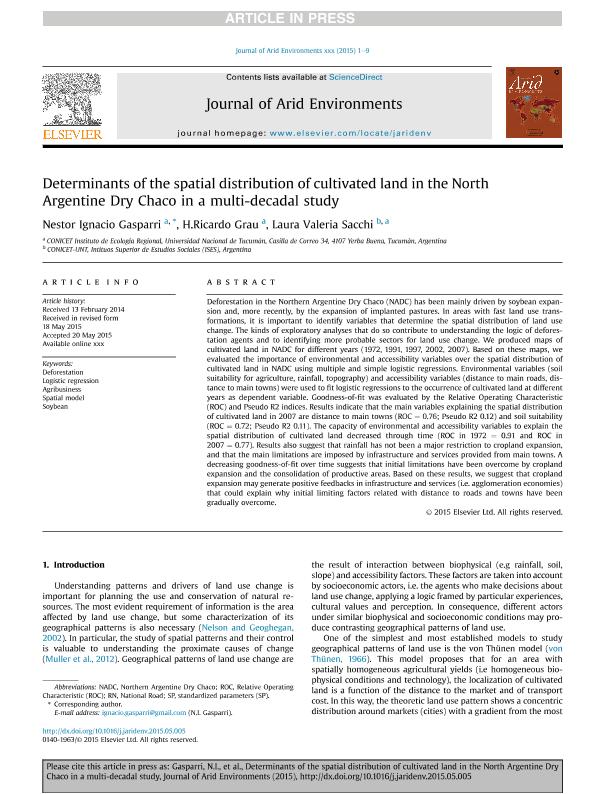Mostrar el registro sencillo del ítem
dc.contributor.author
Gasparri, Nestor Ignacio

dc.contributor.author
Grau, Hector Ricardo

dc.contributor.author
Sacchi, Laura Valeria

dc.date.available
2020-12-10T20:05:05Z
dc.date.issued
2015-12
dc.identifier.citation
Gasparri, Nestor Ignacio; Grau, Hector Ricardo; Sacchi, Laura Valeria; Determinants of the spatial distribution of cultivated land in the North Argentine Dry Chaco in a multi-decadal study; Academic Press Ltd - Elsevier Science Ltd; Journal of Arid Environments; 123; 12-2015; 31-39
dc.identifier.issn
0140-1963
dc.identifier.uri
http://hdl.handle.net/11336/120162
dc.description.abstract
Deforestation in the Northern Argentine Dry Chaco (NADC) has been mainly driven by soybean expansion and, more recently, by the expansion of implanted pastures. In areas with fast land use transformations, it is important to identify variables that determine the spatial distribution of land use change. The kinds of exploratory analyses that do so contribute to understanding the logic of deforestation agents and to identifying more probable sectors for land use change. We produced maps of cultivated land in NADC for different years (1972, 1991, 1997, 2002, 2007). Based on these maps, we evaluated the importance of environmental and accessibility variables over the spatial distribution of cultivated land in NADC using multiple and simple logistic regressions. Environmental variables (soil suitability for agriculture, rainfall, topography) and accessibility variables (distance to main roads, distance to main towns) were used to fit logistic regressions to the occurrence of cultivated land at different years as dependent variable. Goodness-of-fit was evaluated by the Relative Operating Characteristic (ROC) and Pseudo R2 indices. Results indicate that the main variables explaining the spatial distribution of cultivated land in 2007 are distance to main towns (ROC = 0.76; Pseudo R2 0.12) and soil suitability (ROC = 0.72; Pseudo R2 0.11). The capacity of environmental and accessibility variables to explain the spatial distribution of cultivated land decreased through time (ROC in 1972 = 0.91 and ROC in 2007 = 0.77). Results also suggest that rainfall has not been a major restriction to cropland expansion, and that the main limitations are imposed by infrastructure and services provided from main towns. A decreasing goodness-of-fit over time suggests that initial limitations have been overcome by cropland expansion and the consolidation of productive areas. Based on these results, we suggest that cropland expansion may generate positive feedbacks in infrastructure and services (i.e. agglomeration economies) that could explain why initial limiting factors related with distance to roads and towns have been gradually overcome.
dc.format
application/pdf
dc.language.iso
eng
dc.publisher
Academic Press Ltd - Elsevier Science Ltd

dc.rights
info:eu-repo/semantics/openAccess
dc.rights.uri
https://creativecommons.org/licenses/by-nc-sa/2.5/ar/
dc.subject
AGRIBUSINESS
dc.subject
DEFORESTATION
dc.subject
LOGISTIC REGRESSION
dc.subject
SOYBEAN
dc.subject
SPATIAL MODEL
dc.subject.classification
Otras Agricultura, Silvicultura y Pesca

dc.subject.classification
Agricultura, Silvicultura y Pesca

dc.subject.classification
CIENCIAS AGRÍCOLAS

dc.subject.classification
Ciencias Medioambientales

dc.subject.classification
Geografía Económica y Social

dc.subject.classification
CIENCIAS SOCIALES

dc.title
Determinants of the spatial distribution of cultivated land in the North Argentine Dry Chaco in a multi-decadal study
dc.type
info:eu-repo/semantics/article
dc.type
info:ar-repo/semantics/artículo
dc.type
info:eu-repo/semantics/publishedVersion
dc.date.updated
2020-12-04T18:39:56Z
dc.journal.volume
123
dc.journal.pagination
31-39
dc.journal.pais
Estados Unidos

dc.journal.ciudad
Amsterdam
dc.description.fil
Fil: Gasparri, Nestor Ignacio. Universidad Nacional de Tucumán. Instituto de Ecología Regional. Consejo Nacional de Investigaciones Científicas y Técnicas. Centro Científico Tecnológico Conicet - Tucumán. Instituto de Ecología Regional; Argentina
dc.description.fil
Fil: Grau, Hector Ricardo. Universidad Nacional de Tucumán. Instituto de Ecología Regional. Consejo Nacional de Investigaciones Científicas y Técnicas. Centro Científico Tecnológico Conicet - Tucumán. Instituto de Ecología Regional; Argentina
dc.description.fil
Fil: Sacchi, Laura Valeria. Consejo Nacional de Investigaciones Científicas y Técnicas. Centro Científico Tecnológico Conicet - Tucumán. Instituto Superior de Estudios Sociales. Universidad Nacional de Tucumán. Instituto Superior de Estudios Sociales; Argentina
dc.journal.title
Journal of Arid Environments

dc.relation.alternativeid
info:eu-repo/semantics/altIdentifier/url/https://www.sciencedirect.com/science/article/abs/pii/S0140196315001159?via%3Dihub
dc.relation.alternativeid
info:eu-repo/semantics/altIdentifier/doi/https://doi.org/10.1016/j.jaridenv.2015.05.005
Archivos asociados
